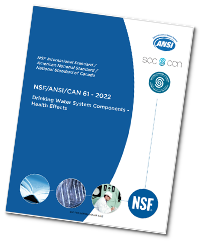NSF 61 Section 9 Standard

Understanding the NSF 61 Section 9 Standard for Water Works and Plumbing Parts


NSF 61 section 9 details mechanical plumbing devices and, more specifically, endpoint devices. Endpoint devices are described as components typically installed in the last liter of the water distribution system.

Types of devices that fall under NSF 61 Section 9 include the following:
- Faucets
- Water dispensers
- Drinking fountains
- Ice makers
- Potable water flexible plumbing hoses
- Supply stops
The 2020 version of the NSF 61 standard set the requirement for new section 9 labelling requirements with an effective date of January 1, 2024. California bill AB100 moved the effective date for California to July 1, 2023.

The “Q-value” references the normalized amount of lead that is leached from a part. In the NSF 61 standard, normalization of leaching levels is used to account for parts that have a very small amount of surface area that contacts the potable water. Leaching results are “normalized” by taking the actual leaching amount, the wetted contact area of the part being tests, and the volume of water held within the part being tested, entering those values into an equation and getting the normalized leaching amount.

The new version of NSF 61 standard requires products to be labeled to include the Q-statistic value for parts that fall under this section. This Q-statistic needs to be on the outer packaging label as well as on the individual part packaging.

While this rule does apply to A.Y. McDonald water works products and any product that touches potable water, none of A.Y. McDonald’s water works products are “endpoint devices” and thus they do not require the special labeling. In addition, not all A.Y. McDonald plumbing products are marked with the Q value, just those that apply to this rule (such as supply hoses and supply stops).

